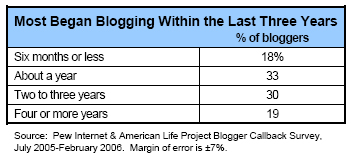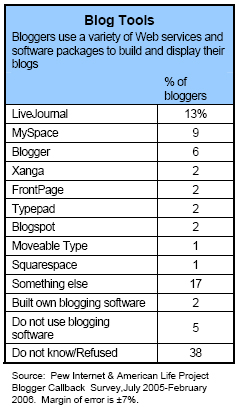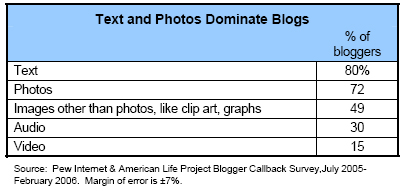The reality of a blogger’s publishing schedule is probably familiar to anyone who juggles a career, a personal life, and a favorite hobby: bloggers cram in their updates when and where they can, and when inspiration strikes.
Most bloggers post infrequently.
While many of the most popular blogs on the internet post material frequently, even multiple times per day, the majority of bloggers do not post nearly so often.10 One-quarter of bloggers post one to two days a week, and about one in seven bloggers (15%) post three to five days a week. Twenty-eight percent of bloggers say they post new material to their blog every few weeks. About one in five bloggers (19%) post every few weeks or less often.
In our sample, 13% post daily or more frequently. Bloggers who have had a personal website in the past are more likely to post material daily to their blog, as are bloggers who report higher than average levels of blog traffic.
Seven in ten bloggers post when inspiration strikes, not on a set schedule.
Most bloggers say they post to their blog when something inspires them. Fully 70% of bloggers only post when inspiration strikes, while 22% of bloggers usually update on a regular schedule. A lucky 4% of bloggers say that both options are true: Inspiration strikes on schedule. Another 4% say that neither mode describes their posting habits, or they were not sure.
The typical blogger spends about two hours per week on their blog.
On average, bloggers do not spend a great deal of time on their blogs. Six in ten bloggers (59%) report spending one to two hours a week on their blog, and another quarter spend 3 to 9 hours a week blogging. One in ten (10%) spend ten or more hours a week tending their blog. Six percent did not answer the question or did not know how many hours they spent per week. Younger bloggers, despite being more likely to keep a blog, generally spend fewer hours per week working on their blog.
Bloggers who spend the least amount of time per week on their blog tend to be the sole author of a single blog and update it mainly for their own enjoyment. Bloggers who spend the most time per week on their blogs (ten or more hours) are more likely to say that lots of bloggers link to their blog.
Most bloggers have blogged three years or less.
A suite of user-friendly blogging tools became available in the summer of 1999, and the practice of blogging achieved high levels of media attention and public awareness during the 2004 presidential campaign. Thus, is it not entirely surprising that most bloggers have been blogging for three years or less.11

Most blog from home.
Two types of location are relevant to blogging—the place where the blogger blogs from, and the space or software that hosts or enables the blog’s public expression. Eight out of ten (83%) of bloggers say that they usually blog from home, while 7% say they usually blog at work, and another 6% blog equally at home and at work. Another 3% say they usually blog from somewhere else, usually a friend or relative’s house, a library, or on-the-go with a mobile device like a cell phone or PDA.
Higher income users are more likely than other groups to say that they blog from work. Thirteen percent of those living in households with more than $75,000 annual income say they blog from work, compared with 3% of those living in households with annual incomes totaling less than $50,000.
LiveJournal tops the list of blogging sites in this survey.
In our sample of bloggers, LiveJournal was the most popular blogging site, with 13% of respondents blogging there. MySpace was next in popularity, followed by Blogger, Xanga, FrontPage, Typepad, Blogspot, Moveable Type and Squarespace. Nearly 1 in 6 (17%) bloggers say they use some other type of blogging software to host their blog, 2% say they built their own software, and 5% say they blog without using specific blogging software at all. Dial-up users are most likely to name MySpace and LiveJournal as their blogging software source.
Some of the responses to this question illustrate the variety of definitions that people apply to blogging. Some respondents told us that they blogged on Facebook, which is generally not considered to be blog hosting software, but where links to blogs may be posted. Other respondents told us they blog at Slashdot, a large long-standing online community focused on technology issues that has been considered by some to be a massive multi-author blog.

Among the various blogging software options, there are some demographic differences among their users. LiveJournal users are more likely to be female (22% of all female bloggers in our sample used LiveJournal compared with only 7% of the males) and young – nearly one in five of our 18-29 year old bloggers used LiveJournal. Blogger had more than its share of college graduates with 13% of college-educated bloggers using Blogger and 12% using LiveJournal as compared with 4% of bloggers with college degrees who use MySpace and 2% who use Xanga. MySpace has a larger share of bloggers who have not yet continued their education past high school.
Text dominates most blogs, but one-third of bloggers post audio files.
As might be expected, writing rules the blogosphere, but bloggers also communicate by sharing a wide array of multimedia content. Most bloggers post text to their blog, in the form of essays, articles or written entries; four out of five bloggers (80%) post text to their blog, but nearly as many (72%) display photos on their blog.

Nearly half of all bloggers (49%) say they have posted images other than photos to their blog – items such as drawings, graphs or clip art.
“Vlog” – a shortened form of the word “videoblog,” which is a blog that features video clips
Close to a third (30%) of bloggers had posted audio files to their blog and another 15% vlogged, or posted video files to their blog. Bloggers who have more than one blog, bloggers who contribute to group blogs and bloggers who report working on their blog three or more hours a week are more likely than other bloggers to post audio and video files to their site, as well as drawings, graphs or clip art.
Blogging for pay is rare.
Even as a subset of bloggers gain prominence in the media and as traffic to blogs grows, blogging is not exactly the most lucrative of hobbies, let alone professions. Only 15% say earning money is a reason they blog and only 8% of bloggers report actual income. These bloggers are mostly older than age 50.
Selling items is the most popular way for this group of bloggers to raise money. About seven in ten bloggers who make money do so by selling things on their site. Bloggers can sell items branded with their own logo or sentiment through fulfillment sites such as CafePress.com or they can join something akin to the Amazon Associates program that allows individuals who recommend an item for sale on the Amazon site to receive a small payment every time someone uses the link the individual provides to purchase the recommended item.
Blog advertisements are another popular way for bloggers to earn money; about half of money-earning bloggers do so through ads. About a third of money-earning bloggers say they get cash from online “tip jars” where readers can leave donations, either through PayPal or another online payment source. Premium content, which readers must pay for, is a source of income for about one in five money-earning bloggers.
Most expect to be blogging a year from now.
Despite its relatively minor importance in the lives of most bloggers, blogging is still an important enough part of their lives that eight out of ten (82%) of bloggers think they will still be blogging a year from now. One in ten bloggers (11%) say they will not, 3% say they have already stopped, and 4% say they are not sure if they will still be blogging in a year.
Bloggers with broadband at home are more likely than those with dial-up connections to say they will continue blogging into next year. Not surprisingly, long-time bloggers are more likely than newcomers to say they will continue, as are bloggers who maintain two or more blogs. Bloggers who say they write mostly for an audience are more likely than those who write mostly for themselves to say they will still be blogging a year from now.
